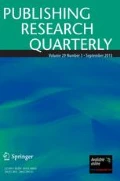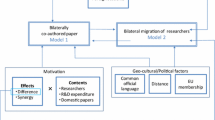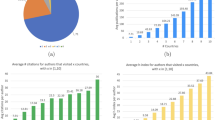Abstract
The purpose of this study was to examine whether scientific mobility, either between countries or between affiliations has an effect on researchers’ productivity and impact. In order to investigate this issue, we examined the relationships between the number of institutional affiliations and countries of the top 100 authors in seven disciplines. The selected authors’ profiles contained the number of affiliations and countries each author is assigned. We studied the number of affiliations and countries and compared them to three bibliometric indicators: the number of publications in international, peer-reviewed journals, h-index and Field Weighted Citations Impact. Our findings show that although there are differences in the relationship between mobility, productivity and impact between disciplines, mobility between at least two affiliations has an overall positive effect on both output and impact while mobility between countries does not. Therefore, in most disciplines positive impact and productivity effects are tracked in affiliation mobility within a single country.










Similar content being viewed by others
References
Ackers L. Moving people and knowledge: scientific mobility in the European Union1. Int Migr. 2005;43(5):99–131.
Aksnes DW, Rørstad K, Piro FN, Sivertsen G. Are mobile researchers more productive and cited than non-mobile researchers? A large-scale study of Norwegian scientists. Res Eval. 2013;22(4):215–23.
Baruffaldi SH, Landoni P. Return mobility and scientific productivity of researchers working abroad: the role of home country linkages. Res Policy. 2012;4(9):1655–65.
Colledge L, Verlinde R (2014). Scival metrics guidebook.Elsevier.com. 2014. Retrieved April 8, 2015, from http://www.elsevier.com/__data/assets/pdf_file/0006/184749/scival-metrics-guidebook-v1_01-february2014.pdf.
David PA, Foray D. Economic fundamentals of the knowledge society. Policy Future Educ. 2003;1(1):20–49.
Fernandez-Zubieta A, Geuna A, Lawson C (2013). Researchers’ mobility and its impact on scientific productivity. Social Sciences Research network.com. 2013. Retrieved May 22, 2015, from http://papers.ssrn.com/sol3/papers.cfm?abstract_id=2244760.
Freeman C. Networks of innovators: a synthesis of research issues. Res Policy. 1991;20(5):499–514.
Gaillard AM, Gaillard J. The international circulation of scientists and technologists. Sci Commun. 1998;20(1):106–15.
Gibson J, McKenzie D. Scientific mobility and knowledge networks in high emigration countries: evidence from the Pacific. Res Policy. 2014;43(9):1486–95.
Iredale R. The migration of professionals: theories and typologies. Int Migr. 2001;39(5):7–26.
Johnson JM, Regets MC (1998). International mobility of scientists and engineers to the united states–brain drain or brain circulation?ERIC.gov. 1998. Retrieved May 22, 2015, from http://eric.ed.gov/?id=ED422166.
Libaers DP. Role and contribution of foreign-born scientists and engineers to the public US nanoscience and technology research enterprise. IEEE Trans Eng Manag. 2007;54(3):423–32.
Lundvall BÅ, Johnson B, Andersen ES, Dalum B. National systems of production, innovation and competence building. Res Policy. 2002;31(2):213–31.
Moed HF. Measuring contextual citation impact of scientific journals. J Informetr. 2010;4:265–77.
Moed HF, Halevi G. A bibliometric approach to tracking international scientific migration. Scientometrics. 2014;101(3):1987–2001.
Saxenian A. From brain drain to brain circulation: transnational communities and regional upgrading in India and China. Stud Comp Int Dev. 2005;40(2):35–61.
Stephan PE, Levin SG. Exceptional contributions to US science by the foreign-born and foreign-educated. Popul Res Policy Rev. 2001;20(1):59–79.
Waltman L, Van Eck NJ, Van Leeuwen ThN, Visser MS. Some modifications to the SNIP journal impact indicator. J Informetr. 2013;7:272–85.
Author information
Authors and Affiliations
Corresponding author
Rights and permissions
About this article
Cite this article
Halevi, G., Moed, H.F. & Bar-Ilan, J. Researchers’ Mobility, Productivity and Impact: Case of Top Producing Authors in Seven Disciplines. Pub Res Q 32, 22–37 (2016). https://doi.org/10.1007/s12109-015-9437-0
Published:
Issue Date:
DOI: https://doi.org/10.1007/s12109-015-9437-0




